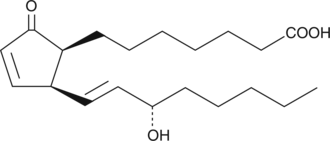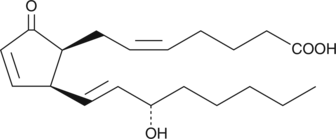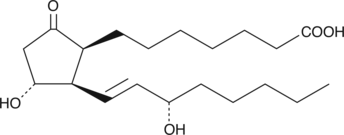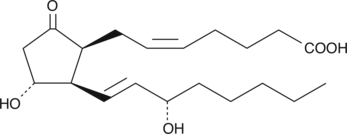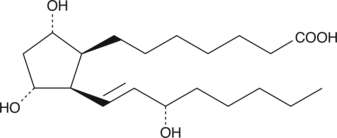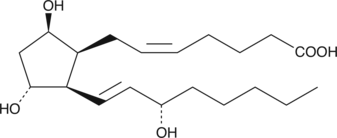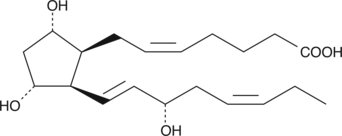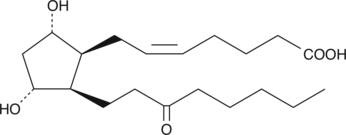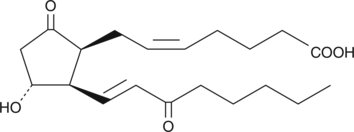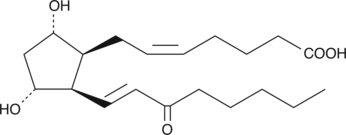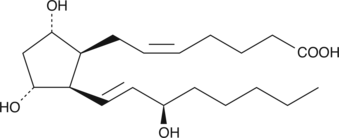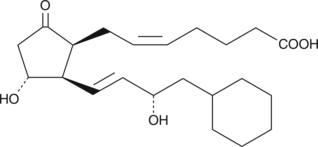Chemicals
Showing 7351–7500 of 41137 results
-
8-hydroxy Loxapine (8-OH loxapine) is a metabolite formed when loxapine (Item No. 20760), an atypical antipsychotic, is metabolized by the cytochrome P450 isoform CYP1A2.{24252,36038} Loxapine displays high affinity for histamine, serotonin (5-HT), dopamine, and α1-adrenergic receptors (Ki values = 7, 7.7, 9.5, 12, and 31 nM for H1, 5-HT2A, 5-HT2C, D2, and α1A-adrenergic receptors, respectively).{24252,24253} It reduces agitation associated with schizophrenia or bipolar disorder.{32724} 8-OH Loxapine is considered inactive as it has relatively low affinity to dopamine and 5-HT receptors compared to the parent compound, however, 8-OH loxapine inhibits [14C]5-HT uptake in vitro (IC50 = 2 μM in human platelets).{36039}
Brand:CaymanSKU:21786 -Out of stock
8-hydroxy Loxapine (8-OH loxapine) is a metabolite formed when loxapine (Item No. 20760), an atypical antipsychotic, is metabolized by the cytochrome P450 isoform CYP1A2.{24252,36038} Loxapine displays high affinity for histamine, serotonin (5-HT), dopamine, and α1-adrenergic receptors (Ki values = 7, 7.7, 9.5, 12, and 31 nM for H1, 5-HT2A, 5-HT2C, D2, and α1A-adrenergic receptors, respectively).{24252,24253} It reduces agitation associated with schizophrenia or bipolar disorder.{32724} 8-OH Loxapine is considered inactive as it has relatively low affinity to dopamine and 5-HT receptors compared to the parent compound, however, 8-OH loxapine inhibits [14C]5-HT uptake in vitro (IC50 = 2 μM in human platelets).{36039}
Brand:CaymanSKU:21786 -Out of stock
8-Hydroxy-2′-deoxyguanosine is produced by oxidative damage of DNA by reactive oxygen and nitrogen species, including hydroxyl radical and peroxynitrite. It serves as a measure of oxidative stress in biological systems.{1239,5022,2239,3718}
Brand:CaymanSKU:89320 - 1 mgAvailable on backorder
8-Hydroxy-2′-deoxyguanosine is produced by oxidative damage of DNA by reactive oxygen and nitrogen species, including hydroxyl radical and peroxynitrite. It serves as a measure of oxidative stress in biological systems.{1239,5022,2239,3718}
Brand:CaymanSKU:89320 - 10 mgAvailable on backorder
8-Hydroxy-2′-deoxyguanosine is produced by oxidative damage of DNA by reactive oxygen and nitrogen species, including hydroxyl radical and peroxynitrite. It serves as a measure of oxidative stress in biological systems.{1239,5022,2239,3718}
Brand:CaymanSKU:89320 - 25 mgAvailable on backorder
8-Hydroxy-2′-deoxyguanosine is produced by oxidative damage of DNA by reactive oxygen and nitrogen species, including hydroxyl radical and peroxynitrite. It serves as a measure of oxidative stress in biological systems.{1239,5022,2239,3718}
Brand:CaymanSKU:89320 - 5 mgAvailable on backorder
8-Hydroxyguanine is produced by oxidative degradation of DNA by hydroxyl radical.{2239,2240,2506} It serves as a measure of oxidative stress in biological systems.{2239,2240}
Brand:CaymanSKU:89290 - 10 mgAvailable on backorder
8-Hydroxyguanine is produced by oxidative degradation of DNA by hydroxyl radical.{2239,2240,2506} It serves as a measure of oxidative stress in biological systems.{2239,2240}
Brand:CaymanSKU:89290 - 100 mgAvailable on backorder
8-Hydroxyguanine is produced by oxidative degradation of DNA by hydroxyl radical.{2239,2240,2506} It serves as a measure of oxidative stress in biological systems.{2239,2240}
Brand:CaymanSKU:89290 - 25 mgAvailable on backorder
8-Hydroxyguanine is produced by oxidative degradation of DNA by hydroxyl radical.{2239,2240,2506} It serves as a measure of oxidative stress in biological systems.{2239,2240}
Brand:CaymanSKU:89290 - 50 mgAvailable on backorder
8-Hydroxyguanosine is produced by oxidative damage of RNA.{1239,5125} It can be measured in cell digests or in biological fluids as a marker of oxidative stress. When 8-hydroxyguanosine (5-8 mM) is added to Friend erythroleukemia cells, it acts as a growth inhibitor in addition to promoting differentiation.{1453,886}
Brand:CaymanSKU:89300 - 1 mgAvailable on backorder
8-Hydroxyguanosine is produced by oxidative damage of RNA.{1239,5125} It can be measured in cell digests or in biological fluids as a marker of oxidative stress. When 8-hydroxyguanosine (5-8 mM) is added to Friend erythroleukemia cells, it acts as a growth inhibitor in addition to promoting differentiation.{1453,886}
Brand:CaymanSKU:89300 - 10 mgAvailable on backorder
8-Hydroxyguanosine is produced by oxidative damage of RNA.{1239,5125} It can be measured in cell digests or in biological fluids as a marker of oxidative stress. When 8-hydroxyguanosine (5-8 mM) is added to Friend erythroleukemia cells, it acts as a growth inhibitor in addition to promoting differentiation.{1453,886}
Brand:CaymanSKU:89300 - 25 mgAvailable on backorder
8-Hydroxyguanosine is produced by oxidative damage of RNA.{1239,5125} It can be measured in cell digests or in biological fluids as a marker of oxidative stress. When 8-hydroxyguanosine (5-8 mM) is added to Friend erythroleukemia cells, it acts as a growth inhibitor in addition to promoting differentiation.{1453,886}
Brand:CaymanSKU:89300 - 5 mgAvailable on backorder
8-Hydroxypyrene-1,3,6-trisulfonic acid (HPTS) is a cell-impermeable fluorescent pH probe.{52382,22782} It displays excitation maxima of 403 and 450 nm, the intensities of which decrease and increase, respectively, as pH increases from 5 to 9 and an emission maximum of 510 nm.{52382} HPTS has been used in excitation ratio imaging to monitor changes in and measure the pH of endocytosed liposomes, acidic organelles, or the cytoplasm in live cell applications.{52382,22782} It is sensitive to fluorescence quenching by viologens, which can be reversed in the presence of glucose or other monosaccharides, and has been used as a glucose and carbohydrate sensor.{37199}
Brand:CaymanSKU:30080 - 1 gAvailable on backorder
8-Hydroxypyrene-1,3,6-trisulfonic acid (HPTS) is a cell-impermeable fluorescent pH probe.{52382,22782} It displays excitation maxima of 403 and 450 nm, the intensities of which decrease and increase, respectively, as pH increases from 5 to 9 and an emission maximum of 510 nm.{52382} HPTS has been used in excitation ratio imaging to monitor changes in and measure the pH of endocytosed liposomes, acidic organelles, or the cytoplasm in live cell applications.{52382,22782} It is sensitive to fluorescence quenching by viologens, which can be reversed in the presence of glucose or other monosaccharides, and has been used as a glucose and carbohydrate sensor.{37199}
Brand:CaymanSKU:30080 - 5 gAvailable on backorder
8-Hydroxypyrene-1,3,6-trisulfonic acid (HPTS) is a cell-impermeable fluorescent pH probe.{52382,22782} It displays excitation maxima of 403 and 450 nm, the intensities of which decrease and increase, respectively, as pH increases from 5 to 9 and an emission maximum of 510 nm.{52382} HPTS has been used in excitation ratio imaging to monitor changes in and measure the pH of endocytosed liposomes, acidic organelles, or the cytoplasm in live cell applications.{52382,22782} It is sensitive to fluorescence quenching by viologens, which can be reversed in the presence of glucose or other monosaccharides, and has been used as a glucose and carbohydrate sensor.{37199}
Brand:CaymanSKU:30080 - 500 mgAvailable on backorder
8-iso Prostaglandin A1 (8-iso PGA1) is an isoprostane and a member in a large family of prostanoids of non-cyclooxygenase origin. It occurs as a common minor impurity in most commercial preparations of PGE1. The biological activity of 8-iso PGA1 has not been studied in depth or reported in the literature.
Brand:CaymanSKU:10035 - 1 mgAvailable on backorder
8-iso Prostaglandin A1 (8-iso PGA1) is an isoprostane and a member in a large family of prostanoids of non-cyclooxygenase origin. It occurs as a common minor impurity in most commercial preparations of PGE1. The biological activity of 8-iso PGA1 has not been studied in depth or reported in the literature.
Brand:CaymanSKU:10035 - 100 µgAvailable on backorder
8-iso Prostaglandin A1 (8-iso PGA1) is an isoprostane and a member in a large family of prostanoids of non-cyclooxygenase origin. It occurs as a common minor impurity in most commercial preparations of PGE1. The biological activity of 8-iso PGA1 has not been studied in depth or reported in the literature.
Brand:CaymanSKU:10035 - 500 µgAvailable on backorder
Isoprostanes are prostaglandin (PG)-like compounds produced in vivo by free radical-catalyzed peroxidation of arachidonoyl-containing lipids. 8-iso PGA2 is one of several isoprostanes produced from peroxidation of arachidonic acid esterified in phospholipids.{1943} 8-iso PGA2 is the dehydration product of 8-iso PGE2, a potent renal vasoconstrictor.{1258} Evidence for the in vivo production of 8-iso PGA2 has been shown in rat liver under conditions of oxidative stress.{14267} There are no published studies of the pharmacological properties of 8-iso PGA2.
Brand:CaymanSKU:10235 - 1 mgAvailable on backorder
Isoprostanes are prostaglandin (PG)-like compounds produced in vivo by free radical-catalyzed peroxidation of arachidonoyl-containing lipids. 8-iso PGA2 is one of several isoprostanes produced from peroxidation of arachidonic acid esterified in phospholipids.{1943} 8-iso PGA2 is the dehydration product of 8-iso PGE2, a potent renal vasoconstrictor.{1258} Evidence for the in vivo production of 8-iso PGA2 has been shown in rat liver under conditions of oxidative stress.{14267} There are no published studies of the pharmacological properties of 8-iso PGA2.
Brand:CaymanSKU:10235 - 500 µgAvailable on backorder
Isoprostanes are a family of prostanoid molecules of non-cyclooxygenase origin.{320} 8-iso Prostaglandin E1 (8-iso PGE1) is an isoprostane which is found in human semen at levels of 7 µg/ml.{1323} It is a pulmonary vasoconstrictor in anesthetized dogs with a potency similar to PGF2α.{2176}
Brand:CaymanSKU:-Isoprostanes are a family of prostanoid molecules of non-cyclooxygenase origin.{320} 8-iso Prostaglandin E1 (8-iso PGE1) is an isoprostane which is found in human semen at levels of 7 µg/ml.{1323} It is a pulmonary vasoconstrictor in anesthetized dogs with a potency similar to PGF2α.{2176}
Brand:CaymanSKU:-Isoprostanes are a family of prostanoid molecules of non-cyclooxygenase origin.{320} 8-iso Prostaglandin E1 (8-iso PGE1) is an isoprostane which is found in human semen at levels of 7 µg/ml.{1323} It is a pulmonary vasoconstrictor in anesthetized dogs with a potency similar to PGF2α.{2176}
Brand:CaymanSKU:-Isoprostanes are a family of prostanoid molecules of non-cyclooxygenase origin.{320} 8-iso Prostaglandin E1 (8-iso PGE1) is an isoprostane which is found in human semen at levels of 7 µg/ml.{1323} It is a pulmonary vasoconstrictor in anesthetized dogs with a potency similar to PGF2α.{2176}
Brand:CaymanSKU:-8-iso PGE2 is one of several isoprostanes produced from arachidonic acid during lipid peroxidation.{1943} It is a potent renal vasoconstrictor in the rat.{1943,5157} 8-iso PGE2 inhibits U-46619 or I-BOP-induced platelet aggregation with IC50 values of 0.5 and 5 µM, respectively.{1258} When infused into the renal artery of the rat at a concentration of 4 µg/kg/min, 8-iso PGE2 decreases the GFR and renal plasma flow by 80% without affecting blood pressure.{1943}
Brand:CaymanSKU:-8-iso PGE2 is one of several isoprostanes produced from arachidonic acid during lipid peroxidation.{1943} It is a potent renal vasoconstrictor in the rat.{1943,5157} 8-iso PGE2 inhibits U-46619 or I-BOP-induced platelet aggregation with IC50 values of 0.5 and 5 µM, respectively.{1258} When infused into the renal artery of the rat at a concentration of 4 µg/kg/min, 8-iso PGE2 decreases the GFR and renal plasma flow by 80% without affecting blood pressure.{1943}
Brand:CaymanSKU:-8-iso PGE2 is one of several isoprostanes produced from arachidonic acid during lipid peroxidation.{1943} It is a potent renal vasoconstrictor in the rat.{1943,5157} 8-iso PGE2 inhibits U-46619 or I-BOP-induced platelet aggregation with IC50 values of 0.5 and 5 µM, respectively.{1258} When infused into the renal artery of the rat at a concentration of 4 µg/kg/min, 8-iso PGE2 decreases the GFR and renal plasma flow by 80% without affecting blood pressure.{1943}
Brand:CaymanSKU:-8-iso PGE2 is one of several isoprostanes produced from arachidonic acid during lipid peroxidation.{1943} It is a potent renal vasoconstrictor in the rat.{1943,5157} 8-iso PGE2 inhibits U-46619 or I-BOP-induced platelet aggregation with IC50 values of 0.5 and 5 µM, respectively.{1258} When infused into the renal artery of the rat at a concentration of 4 µg/kg/min, 8-iso PGE2 decreases the GFR and renal plasma flow by 80% without affecting blood pressure.{1943}
Brand:CaymanSKU:-8-iso PGE2 isopropyl ester is a more lipophilic form of the free acid, 8-iso PGE2. Prostaglandin esters have enhanced lipid solubility compared to their parent compounds. They are generally hydrolyzed to the free acid upon in vivo administration, making the esters useful prodrugs. In general, the C-1 esters of prostaglandins show greatly diminished agonist activity in vitro compared to the parent free acids.
Brand:CaymanSKU:-8-iso PGE2 isopropyl ester is a more lipophilic form of the free acid, 8-iso PGE2. Prostaglandin esters have enhanced lipid solubility compared to their parent compounds. They are generally hydrolyzed to the free acid upon in vivo administration, making the esters useful prodrugs. In general, the C-1 esters of prostaglandins show greatly diminished agonist activity in vitro compared to the parent free acids.
Brand:CaymanSKU:-8-iso PGE2 isopropyl ester is a more lipophilic form of the free acid, 8-iso PGE2. Prostaglandin esters have enhanced lipid solubility compared to their parent compounds. They are generally hydrolyzed to the free acid upon in vivo administration, making the esters useful prodrugs. In general, the C-1 esters of prostaglandins show greatly diminished agonist activity in vitro compared to the parent free acids.
Brand:CaymanSKU:-8-iso PGF1α is an isoprostane that was first identified in human semen.{1181} It is a member of the isoprostane family, which are eicosanoids of non-cyclooxygenase origin. 8-iso PGF1α is present along with its 19-hydroxy congener at 5-10 µg/ml of seminal plasma.{1323}
Brand:CaymanSKU:-8-iso PGF1α is an isoprostane that was first identified in human semen.{1181} It is a member of the isoprostane family, which are eicosanoids of non-cyclooxygenase origin. 8-iso PGF1α is present along with its 19-hydroxy congener at 5-10 µg/ml of seminal plasma.{1323}
Brand:CaymanSKU:-8-iso PGF1α is an isoprostane that was first identified in human semen.{1181} It is a member of the isoprostane family, which are eicosanoids of non-cyclooxygenase origin. 8-iso PGF1α is present along with its 19-hydroxy congener at 5-10 µg/ml of seminal plasma.{1323}
Brand:CaymanSKU:-8-iso PGF1β is a potential autoxidation product of DGLA. There are no published reports on its isolation from any biological source or on its biological activity.
Brand:CaymanSKU:-8-iso PGF1β is a potential autoxidation product of DGLA. There are no published reports on its isolation from any biological source or on its biological activity.
Brand:CaymanSKU:-8-iso PGF1β is a potential autoxidation product of DGLA. There are no published reports on its isolation from any biological source or on its biological activity.
Brand:CaymanSKU:-8-iso PGF2α is an isoprostane produced by the non-enzymatic peroxidation of arachidonic acid in membrane phospholipids.{320,371,855} It is present in human plasma in two distinct forms – esterified in phospholipids and as the free acid. The ratio of these two forms is approximately 2:1, with a total plasma 8-iso PGF2α level of about 150 pg/ml in normal volunteers. In normal human urine, 8-iso PGF2α levels are about 180-200 pg/mg of creatinine.{320,371} 8-iso PGF2α is a weak TP receptor agonist in vascular smooth muscle.{6640} Conversely, 8-iso PGF2α inhibits platelet aggregation induced by U-46619 (10−6 M) and I-BOP (3 x 10−7 M) with IC50 values of 1.6 x 10−6 M and 1.8 x 10−6 M, respectively.{855}
Brand:CaymanSKU:-Out of stock
8-iso PGF2α is an isoprostane produced by the non-enzymatic peroxidation of arachidonic acid in membrane phospholipids.{320,371,855} It is present in human plasma in two distinct forms – esterified in phospholipids and as the free acid. The ratio of these two forms is approximately 2:1, with a total plasma 8-iso PGF2α level of about 150 pg/ml in normal volunteers. In normal human urine, 8-iso PGF2α levels are about 180-200 pg/mg of creatinine.{320,371} 8-iso PGF2α is a weak TP receptor agonist in vascular smooth muscle.{6640} Conversely, 8-iso PGF2α inhibits platelet aggregation induced by U-46619 (10−6 M) and I-BOP (3 x 10−7 M) with IC50 values of 1.6 x 10−6 M and 1.8 x 10−6 M, respectively.{855}
Brand:CaymanSKU:-Out of stock
8-iso PGF2α is an isoprostane produced by the non-enzymatic peroxidation of arachidonic acid in membrane phospholipids.{320,371,855} It is present in human plasma in two distinct forms – esterified in phospholipids and as the free acid. The ratio of these two forms is approximately 2:1, with a total plasma 8-iso PGF2α level of about 150 pg/ml in normal volunteers. In normal human urine, 8-iso PGF2α levels are about 180-200 pg/mg of creatinine.{320,371} 8-iso PGF2α is a weak TP receptor agonist in vascular smooth muscle.{6640} Conversely, 8-iso PGF2α inhibits platelet aggregation induced by U-46619 (10−6 M) and I-BOP (3 x 10−7 M) with IC50 values of 1.6 x 10−6 M and 1.8 x 10−6 M, respectively.{855}
Brand:CaymanSKU:-Out of stock
8-iso Prostaglandin F2α (8-iso PGF2α) is an isoprostane produced by the non-enzymatic peroxidation of arachidonic acid in membrane phospholipids.{320,371,855} It is present in human plasma in two distinct forms – esterified in phospholipids and as the free acid. The ratio of these two forms is approximately 2:1, with a total plasma 8-iso PGF2α level of about 150 pg/ml in normal volunteers. In normal human urine, 8-iso PGF2α levels are about 180-200 pg/mg of creatinine.{320,371} 8-iso PGF2α is a weak TP receptor agonist in vascular smooth muscle.{6640} Conversely, 8-iso PGF2α inhibits platelet aggregation induced by U-46619 (10−6 M) and I-BOP (3 x 10−7 M) with IC50 values of 1.6 x 10−6 M and 1.8 x 10−6 M, respectively.{855} 8-iso Prostaglandin F2α MaxSpec® standard is a quantitative grade standard of 8-iso Prostaglandin F2α (Item No. 16350) that has been prepared specifically for mass spectrometry and related applications where quantitative reproducibility is required. The solution has been prepared gravimetrically and is supplied in a deactivated glass ampule sealed under argon. The concentration was verified by comparison to an independently prepared calibration standard. This 8-iso Prostaglandin F2α MaxSpec® standard is guaranteed to meet identity, purity, stability, and concentration specifications and is provided with a batch-specific certificate of analysis. Ongoing stability testing is performed to ensure the concentration remains accurate throughout the shelf life of the product. Note: The amount of solution added to the vial is in excess of the listed amount. Therefore, it is necessary to accurately measure volumes for preparation of calibration standards. Follow recommended storage and handling conditions to maintain product quality.
Brand:CaymanSKU:25903 - 100 µgAvailable on backorder
8-iso PGF2α-d4 contains four deuterium atoms at the 3, 3′, 4, and 4′ positions. It is intended for use as an internal standard for the quantification of 8-iso PGF2α by GC- or LC-mass spectrometry. 8-iso Prostaglandin F2α (8-iso PGF2α) is an isoprostane produced by the non-enzymatic peroxidation of arachidonic acid in membrane phospholipids.{320,371,855} It circulates in human plasma in two distinct forms – esterified in LDL phospholipids and as the free acid. The ratio of these two forms is approximately 2:1, with a total plasma 8-iso PGF2α level of about 150 pg/ml in normal volunteers. In normal human urine, 8-iso PGF2α levels are about 180-200 pg/mg of creatinine.{320,371} 8-iso PGF2α is a weak TP receptor agonist in vascular smooth muscle.{6640} Conversely, 8-iso PGF2α inhibits platelet aggregation induced by U-46619 (10−6 M) and I-BOP (3 x 10−7 M) with IC50 values of 1.6 x 10−6 M and 1.8 x 10−6 M, respectively.{855}
Brand:CaymanSKU:316350 - 100 µgAvailable on backorder
8-iso PGF2α-d4 contains four deuterium atoms at the 3, 3′, 4, and 4′ positions. It is intended for use as an internal standard for the quantification of 8-iso PGF2α by GC- or LC-mass spectrometry. 8-iso Prostaglandin F2α (8-iso PGF2α) is an isoprostane produced by the non-enzymatic peroxidation of arachidonic acid in membrane phospholipids.{320,371,855} It circulates in human plasma in two distinct forms – esterified in LDL phospholipids and as the free acid. The ratio of these two forms is approximately 2:1, with a total plasma 8-iso PGF2α level of about 150 pg/ml in normal volunteers. In normal human urine, 8-iso PGF2α levels are about 180-200 pg/mg of creatinine.{320,371} 8-iso PGF2α is a weak TP receptor agonist in vascular smooth muscle.{6640} Conversely, 8-iso PGF2α inhibits platelet aggregation induced by U-46619 (10−6 M) and I-BOP (3 x 10−7 M) with IC50 values of 1.6 x 10−6 M and 1.8 x 10−6 M, respectively.{855}
Brand:CaymanSKU:316350 - 25 µgAvailable on backorder
8-iso PGF2α-d4 contains four deuterium atoms at the 3, 3′, 4, and 4′ positions. It is intended for use as an internal standard for the quantification of 8-iso PGF2α by GC- or LC-mass spectrometry. 8-iso Prostaglandin F2α (8-iso PGF2α) is an isoprostane produced by the non-enzymatic peroxidation of arachidonic acid in membrane phospholipids.{320,371,855} It circulates in human plasma in two distinct forms – esterified in LDL phospholipids and as the free acid. The ratio of these two forms is approximately 2:1, with a total plasma 8-iso PGF2α level of about 150 pg/ml in normal volunteers. In normal human urine, 8-iso PGF2α levels are about 180-200 pg/mg of creatinine.{320,371} 8-iso PGF2α is a weak TP receptor agonist in vascular smooth muscle.{6640} Conversely, 8-iso PGF2α inhibits platelet aggregation induced by U-46619 (10−6 M) and I-BOP (3 x 10−7 M) with IC50 values of 1.6 x 10−6 M and 1.8 x 10−6 M, respectively.{855}
Brand:CaymanSKU:316350 - 50 µgAvailable on backorder
8-iso PGF2α-d4 contains four deuterium atoms at the 3, 3′, 4, and 4′ positions. It is intended for use as an internal standard for the quantification of 8-iso PGF2α by GC- or LC-mass spectrometry. 8-iso Prostaglandin F2α (8-iso PGF2α) is an isoprostane produced by the non-enzymatic peroxidation of arachidonic acid in membrane phospholipids.{320,371,855} It circulates in human plasma in two distinct forms – esterified in LDL phospholipids and as the free acid. The ratio of these two forms is approximately 2:1, with a total plasma 8-iso PGF2α level of about 150 pg/ml in normal volunteers. In normal human urine, 8-iso PGF2α levels are about 180-200 pg/mg of creatinine.{320,371} 8-iso PGF2α is a weak TP receptor agonist in vascular smooth muscle.{6640} Conversely, 8-iso PGF2α inhibits platelet aggregation induced by U-46619 (10−6 M) and I-BOP (3 x 10−7 M) with IC50 values of 1.6 x 10−6 M and 1.8 x 10−6 M, respectively.{855}
Brand:CaymanSKU:316350 - 500 µgAvailable on backorder
8-iso Prostaglandin F2β (8-iso PGF2β) is an isomer of PGF2α with a non-enzymatic, non-cyclooxygenase origin. It is one of 64 possible isomers of PGF2α which can be produced by free radical peroxidation of arachidonic acid. 8-iso PGF2β exhibits very weak contraction of human umbilical vein artery{11143} and does not promote aggregation of human whole blood.{11143,11145} However, 8-iso PGF2β moderately contracts both the canine and porcine pulmonary vein, although the effect is much weaker than that exhibited by other isoprostanes such as 8-iso PGE1, 8-iso PGE2, or 8-iso PGF2α{11144,11146}
Brand:CaymanSKU:-Out of stock
8-iso Prostaglandin F2β (8-iso PGF2β) is an isomer of PGF2α with a non-enzymatic, non-cyclooxygenase origin. It is one of 64 possible isomers of PGF2α which can be produced by free radical peroxidation of arachidonic acid. 8-iso PGF2β exhibits very weak contraction of human umbilical vein artery{11143} and does not promote aggregation of human whole blood.{11143,11145} However, 8-iso PGF2β moderately contracts both the canine and porcine pulmonary vein, although the effect is much weaker than that exhibited by other isoprostanes such as 8-iso PGE1, 8-iso PGE2, or 8-iso PGF2α{11144,11146}
Brand:CaymanSKU:-Out of stock
8-iso Prostaglandin F2β (8-iso PGF2β) is an isomer of PGF2α with a non-enzymatic, non-cyclooxygenase origin. It is one of 64 possible isomers of PGF2α which can be produced by free radical peroxidation of arachidonic acid. 8-iso PGF2β exhibits very weak contraction of human umbilical vein artery{11143} and does not promote aggregation of human whole blood.{11143,11145} However, 8-iso PGF2β moderately contracts both the canine and porcine pulmonary vein, although the effect is much weaker than that exhibited by other isoprostanes such as 8-iso PGE1, 8-iso PGE2, or 8-iso PGF2α{11144,11146}
Brand:CaymanSKU:-Out of stock
8-iso PGF3α is an isoprostane produced from the free-radical peroxidation of EPA. Little is known about the biological activity of 8-iso PGF3α. There is one report that it is inactive in a TP receptor mediated assay of human platelet shape change, where 8-iso PGF2α has an ED50 value of 1 µM.{2772}
Brand:CaymanSKU:-Out of stock
8-iso PGF3α is an isoprostane produced from the free-radical peroxidation of EPA. Little is known about the biological activity of 8-iso PGF3α. There is one report that it is inactive in a TP receptor mediated assay of human platelet shape change, where 8-iso PGF2α has an ED50 value of 1 µM.{2772}
Brand:CaymanSKU:-Out of stock
8-iso PGF3α is an isoprostane produced from the free-radical peroxidation of EPA. Little is known about the biological activity of 8-iso PGF3α. There is one report that it is inactive in a TP receptor mediated assay of human platelet shape change, where 8-iso PGF2α has an ED50 value of 1 µM.{2772}
Brand:CaymanSKU:-Out of stock
8-iso-13,14-dihydro-15-keto Prostaglandin F2α (8-iso-13,14-dihydro-15-keto PGF2α) is a metabolite of the isoprostane, 8-isoprostane (8-iso PGF2α), in rabbits, monkeys and humans.{6907} 8-iso PGF2α is a PG-like product of non-specific lipid peroxidation.{320} In both humans and monkeys, exogenously infused 8-isoprostane is converted primarily to metabolites having 2 or 4 carbon atoms removed from the top side chain by β-oxidation.{6907} A similar pattern is observed when tritiated 8-isoprostane is infused into rabbits.{11209} Early in the infusion (within 10 minutes) 8-iso-13,14-dihydro-15-keto PGF2α was a significant component of the metabolite profile, which was comprised mostly of dinor 8-isoprostane metabolites. 8-iso-13,14-dihydro-15-keto PGF2α weakly inhibits the U-46619 or collagen-induced aggregation of human platelets, although a number of the E-series isoprostanes are much more potent in this assay.{11145}
Brand:CaymanSKU:-Out of stock
8-iso-13,14-dihydro-15-keto Prostaglandin F2α (8-iso-13,14-dihydro-15-keto PGF2α) is a metabolite of the isoprostane, 8-isoprostane (8-iso PGF2α), in rabbits, monkeys and humans.{6907} 8-iso PGF2α is a PG-like product of non-specific lipid peroxidation.{320} In both humans and monkeys, exogenously infused 8-isoprostane is converted primarily to metabolites having 2 or 4 carbon atoms removed from the top side chain by β-oxidation.{6907} A similar pattern is observed when tritiated 8-isoprostane is infused into rabbits.{11209} Early in the infusion (within 10 minutes) 8-iso-13,14-dihydro-15-keto PGF2α was a significant component of the metabolite profile, which was comprised mostly of dinor 8-isoprostane metabolites. 8-iso-13,14-dihydro-15-keto PGF2α weakly inhibits the U-46619 or collagen-induced aggregation of human platelets, although a number of the E-series isoprostanes are much more potent in this assay.{11145}
Brand:CaymanSKU:-Out of stock
8-iso-13,14-dihydro-15-keto Prostaglandin F2α (8-iso-13,14-dihydro-15-keto PGF2α) is a metabolite of the isoprostane, 8-isoprostane (8-iso PGF2α), in rabbits, monkeys and humans.{6907} 8-iso PGF2α is a PG-like product of non-specific lipid peroxidation.{320} In both humans and monkeys, exogenously infused 8-isoprostane is converted primarily to metabolites having 2 or 4 carbon atoms removed from the top side chain by β-oxidation.{6907} A similar pattern is observed when tritiated 8-isoprostane is infused into rabbits.{11209} Early in the infusion (within 10 minutes) 8-iso-13,14-dihydro-15-keto PGF2α was a significant component of the metabolite profile, which was comprised mostly of dinor 8-isoprostane metabolites. 8-iso-13,14-dihydro-15-keto PGF2α weakly inhibits the U-46619 or collagen-induced aggregation of human platelets, although a number of the E-series isoprostanes are much more potent in this assay.{11145}
Brand:CaymanSKU:-Out of stock
8-iso-13,14-dihydro-15-keto Prostaglandin F2α (8-iso-13,14-dihydro-15-keto PGF2α) is a metabolite of the isoprostane, 8-isoprostane (8-iso PGF2α), in rabbits, monkeys and humans.{6907} 8-iso PGF2α is a PG-like product of non-specific lipid peroxidation.{320} In both humans and monkeys, exogenously infused 8-isoprostane is converted primarily to metabolites having 2 or 4 carbon atoms removed from the top side chain by β-oxidation.{6907} A similar pattern is observed when tritiated 8-isoprostane is infused into rabbits.{11209} Early in the infusion (within 10 minutes) 8-iso-13,14-dihydro-15-keto PGF2α was a significant component of the metabolite profile, which was comprised mostly of dinor 8-isoprostane metabolites. 8-iso-13,14-dihydro-15-keto PGF2α weakly inhibits the U-46619 or collagen-induced aggregation of human platelets, although a number of the E-series isoprostanes are much more potent in this assay.{11145}
Brand:CaymanSKU:-Out of stock
8-iso-15-keto Prostaglandin E2 (8-iso-15-keto PGE2) is an isoprostane, one member of a large family of biomarkers produced by the free radical peroxidative degradation of membrane lipids.{320} 8-iso-15-keto PGE2 is the theoretical first metabolite of 8-iso PGE2 via the 15-hydroxy PGDH pathway. While a number of potent biological activities have been attributed to 8-iso PGE2,{1258} there are no published reports at this time regarding its metabolism.
Brand:CaymanSKU:-8-iso-15-keto Prostaglandin E2 (8-iso-15-keto PGE2) is an isoprostane, one member of a large family of biomarkers produced by the free radical peroxidative degradation of membrane lipids.{320} 8-iso-15-keto PGE2 is the theoretical first metabolite of 8-iso PGE2 via the 15-hydroxy PGDH pathway. While a number of potent biological activities have been attributed to 8-iso PGE2,{1258} there are no published reports at this time regarding its metabolism.
Brand:CaymanSKU:-8-iso-15-keto Prostaglandin E2 (8-iso-15-keto PGE2) is an isoprostane, one member of a large family of biomarkers produced by the free radical peroxidative degradation of membrane lipids.{320} 8-iso-15-keto PGE2 is the theoretical first metabolite of 8-iso PGE2 via the 15-hydroxy PGDH pathway. While a number of potent biological activities have been attributed to 8-iso PGE2,{1258} there are no published reports at this time regarding its metabolism.
Brand:CaymanSKU:-8-iso-15-keto Prostaglandin E2 (8-iso-15-keto PGE2) is an isoprostane, one member of a large family of biomarkers produced by the free radical peroxidative degradation of membrane lipids.{320} 8-iso-15-keto PGE2 is the theoretical first metabolite of 8-iso PGE2 via the 15-hydroxy PGDH pathway. While a number of potent biological activities have been attributed to 8-iso PGE2,{1258} there are no published reports at this time regarding its metabolism.
Brand:CaymanSKU:-8-iso-15-keto Prostaglandin F2α (8-iso-15-keto PGF2α) is a metabolite of the isoprostane 8-iso PGF2α in rabbits, monkeys, and humans. 8-isoprostane (8-iso PGF2α) is a prostaglandin-like product of non-specific lipid peroxidation.{320} In both humans and monkeys, exogenously infused 8-iso PGF2α is converted primarily to metabolites having 2 or 4 carbon atoms removed from the top side chain by β-oxidation.{6907} A similar pattern is observed when tritiated 8-iso PGF2α is infused into rabbits.{11209} Early in the infusion (within 1-2 minutes) 8-iso -15-keto PGF2α was a major component of the metabolite profile, which was comprised mostly of unmetabolized 8-iso PGF2α. 8-iso -15-keto PGF2α is a vasoconstrictor when tested on the rat isolated thoracic aorta, acting via the TP (thromboxane) receptor.{11221}
Brand:CaymanSKU:-Out of stock
8-iso-15-keto Prostaglandin F2α (8-iso-15-keto PGF2α) is a metabolite of the isoprostane 8-iso PGF2α in rabbits, monkeys, and humans. 8-isoprostane (8-iso PGF2α) is a prostaglandin-like product of non-specific lipid peroxidation.{320} In both humans and monkeys, exogenously infused 8-iso PGF2α is converted primarily to metabolites having 2 or 4 carbon atoms removed from the top side chain by β-oxidation.{6907} A similar pattern is observed when tritiated 8-iso PGF2α is infused into rabbits.{11209} Early in the infusion (within 1-2 minutes) 8-iso -15-keto PGF2α was a major component of the metabolite profile, which was comprised mostly of unmetabolized 8-iso PGF2α. 8-iso -15-keto PGF2α is a vasoconstrictor when tested on the rat isolated thoracic aorta, acting via the TP (thromboxane) receptor.{11221}
Brand:CaymanSKU:-Out of stock
8-iso-15-keto Prostaglandin F2α (8-iso-15-keto PGF2α) is a metabolite of the isoprostane 8-iso PGF2α in rabbits, monkeys, and humans. 8-isoprostane (8-iso PGF2α) is a prostaglandin-like product of non-specific lipid peroxidation.{320} In both humans and monkeys, exogenously infused 8-iso PGF2α is converted primarily to metabolites having 2 or 4 carbon atoms removed from the top side chain by β-oxidation.{6907} A similar pattern is observed when tritiated 8-iso PGF2α is infused into rabbits.{11209} Early in the infusion (within 1-2 minutes) 8-iso -15-keto PGF2α was a major component of the metabolite profile, which was comprised mostly of unmetabolized 8-iso PGF2α. 8-iso -15-keto PGF2α is a vasoconstrictor when tested on the rat isolated thoracic aorta, acting via the TP (thromboxane) receptor.{11221}
Brand:CaymanSKU:-Out of stock
8-iso Prostaglandin F2β (8-iso PGF2β) is an isomer of PGF2α of non-enzymatic origin. It is one of 64 possible isomers of PGF2α which can be produced by free radical peroxidation of arachidonic acid. 8-iso PGF2β exhibits very weak contraction of human umbilical vein artery and does not promote aggregation of human whole blood.{11143,11145} However, 8-iso PGF2β moderately contracts both the canine and porcine pulmonary vein, although the effect is much weaker than that exhibited by other isoprostanes such as 8-iso PGE1, 8-iso PGE2, or 8-iso PGF2α.{11144,11146} 8-iso-15-keto PGF2β is a potential metabolite of 8-iso PGF2β via the 15-hydroxy PG dehydrogenase pathway. There are no published reports on the formation or biological activity of 8-iso-15-keto PGF2β.
Brand:CaymanSKU:10008539 - 1 mgAvailable on backorder
8-iso Prostaglandin F2β (8-iso PGF2β) is an isomer of PGF2α of non-enzymatic origin. It is one of 64 possible isomers of PGF2α which can be produced by free radical peroxidation of arachidonic acid. 8-iso PGF2β exhibits very weak contraction of human umbilical vein artery and does not promote aggregation of human whole blood.{11143,11145} However, 8-iso PGF2β moderately contracts both the canine and porcine pulmonary vein, although the effect is much weaker than that exhibited by other isoprostanes such as 8-iso PGE1, 8-iso PGE2, or 8-iso PGF2α.{11144,11146} 8-iso-15-keto PGF2β is a potential metabolite of 8-iso PGF2β via the 15-hydroxy PG dehydrogenase pathway. There are no published reports on the formation or biological activity of 8-iso-15-keto PGF2β.
Brand:CaymanSKU:10008539 - 100 µgAvailable on backorder
8-iso Prostaglandin F2β (8-iso PGF2β) is an isomer of PGF2α of non-enzymatic origin. It is one of 64 possible isomers of PGF2α which can be produced by free radical peroxidation of arachidonic acid. 8-iso PGF2β exhibits very weak contraction of human umbilical vein artery and does not promote aggregation of human whole blood.{11143,11145} However, 8-iso PGF2β moderately contracts both the canine and porcine pulmonary vein, although the effect is much weaker than that exhibited by other isoprostanes such as 8-iso PGE1, 8-iso PGE2, or 8-iso PGF2α.{11144,11146} 8-iso-15-keto PGF2β is a potential metabolite of 8-iso PGF2β via the 15-hydroxy PG dehydrogenase pathway. There are no published reports on the formation or biological activity of 8-iso-15-keto PGF2β.
Brand:CaymanSKU:10008539 - 500 µgAvailable on backorder
8-iso-15(R) PGF2α is one member of a large family of prostaglandin-like eicosanoids formed by the free radical peroxidation of arachidonic acid in membrane phospholipids.{371} It is the C-15 epimer of 8-iso PGF2α, the only isoprostane isomer which has been studied in depth in a variety of biological systems.{855}
Brand:CaymanSKU:-Out of stock
8-iso-15(R) PGF2α is one member of a large family of prostaglandin-like eicosanoids formed by the free radical peroxidation of arachidonic acid in membrane phospholipids.{371} It is the C-15 epimer of 8-iso PGF2α, the only isoprostane isomer which has been studied in depth in a variety of biological systems.{855}
Brand:CaymanSKU:-Out of stock
8-iso-15(R) PGF2α is one member of a large family of prostaglandin-like eicosanoids formed by the free radical peroxidation of arachidonic acid in membrane phospholipids.{371} It is the C-15 epimer of 8-iso PGF2α, the only isoprostane isomer which has been studied in depth in a variety of biological systems.{855}
Brand:CaymanSKU:-Out of stock
8-iso-15(R) PGF2α is one member of a large family of prostaglandin-like eicosanoids formed by the free radical peroxidation of arachidonic acid in membrane phospholipids.{371} It is the C-15 epimer of 8-iso PGF2α, the only isoprostane isomer which has been studied in depth in a variety of biological systems.{855}
Brand:CaymanSKU:-Out of stock
8-iso Prostaglandin E2 (8-iso PGE2) is one of several isoprostanes produced from polyunsaturated fatty acids during lipid peroxidation.{1943} 8-iso-16-cyclohexyl-tetranor PGE2 is a synthetic analog of 8-iso PGE2. There are no published studies on the pharmacological properties of 8-iso-16-cyclohexyl-tetranor PGE2.
Brand:CaymanSKU:10009278 - 1 mgAvailable on backorder
8-iso Prostaglandin E2 (8-iso PGE2) is one of several isoprostanes produced from polyunsaturated fatty acids during lipid peroxidation.{1943} 8-iso-16-cyclohexyl-tetranor PGE2 is a synthetic analog of 8-iso PGE2. There are no published studies on the pharmacological properties of 8-iso-16-cyclohexyl-tetranor PGE2.
Brand:CaymanSKU:10009278 - 100 µgAvailable on backorder
8-iso Prostaglandin E2 (8-iso PGE2) is one of several isoprostanes produced from polyunsaturated fatty acids during lipid peroxidation.{1943} 8-iso-16-cyclohexyl-tetranor PGE2 is a synthetic analog of 8-iso PGE2. There are no published studies on the pharmacological properties of 8-iso-16-cyclohexyl-tetranor PGE2.
Brand:CaymanSKU:10009278 - 500 µgAvailable on backorder
8-Isoquinoline methanamine (hydrochloride) is a synthetic intermediate useful for pharmaceutical synthesis.
Brand:CaymanSKU:10007125 - 100 mgAvailable on backorder
8-Isoquinoline methanamine (hydrochloride) is a synthetic intermediate useful for pharmaceutical synthesis.
Brand:CaymanSKU:10007125 - 50 mgAvailable on backorder
8-Isoquinoline methanamine (hydrochloride) is a synthetic intermediate useful for pharmaceutical synthesis.
Brand:CaymanSKU:10007125 - 500 mgAvailable on backorder
8-M-PDOT is a melatonin receptor 2 (MT2) agonist (Ki = 1.12 nM).{26021} It is 5.2-fold selective for MT2 over MT1 receptors in a radioligand binding assay. Striatal microinfusion of 8-M-PDOT (10 μg/μl) increases the percentage of time spent in the open arms of the elevated plus maze, indicating anxiolytic-like activity, in a rat model of rotenone-induced Parkinson’s disease.{47781}
Brand:CaymanSKU:29521 - 10 mgAvailable on backorder
8-M-PDOT is a melatonin receptor 2 (MT2) agonist (Ki = 1.12 nM).{26021} It is 5.2-fold selective for MT2 over MT1 receptors in a radioligand binding assay. Striatal microinfusion of 8-M-PDOT (10 μg/μl) increases the percentage of time spent in the open arms of the elevated plus maze, indicating anxiolytic-like activity, in a rat model of rotenone-induced Parkinson’s disease.{47781}
Brand:CaymanSKU:29521 - 25 mgAvailable on backorder
8-M-PDOT is a melatonin receptor 2 (MT2) agonist (Ki = 1.12 nM).{26021} It is 5.2-fold selective for MT2 over MT1 receptors in a radioligand binding assay. Striatal microinfusion of 8-M-PDOT (10 μg/μl) increases the percentage of time spent in the open arms of the elevated plus maze, indicating anxiolytic-like activity, in a rat model of rotenone-induced Parkinson’s disease.{47781}
Brand:CaymanSKU:29521 - 5 mgAvailable on backorder
8-M-PDOT is a melatonin receptor 2 (MT2) agonist (Ki = 1.12 nM).{26021} It is 5.2-fold selective for MT2 over MT1 receptors in a radioligand binding assay. Striatal microinfusion of 8-M-PDOT (10 μg/μl) increases the percentage of time spent in the open arms of the elevated plus maze, indicating anxiolytic-like activity, in a rat model of rotenone-induced Parkinson’s disease.{47781}
Brand:CaymanSKU:29521 - 50 mgAvailable on backorder
![A loxapine metabolite; inhibits [14C]5-HT uptake in vitro (IC50 = 2 μM in human platelets)](https://interpriseusa.com/wp-content/uploads/2021/06/21786.png)




